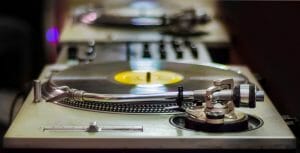Direct Drive vs. Belt Driven Turntables: What is the Difference?
The DJ crowd has long been debating over which type of turntable is better for mixing – belt driven, or direct drive ones. And while we are firm supporters of direct drive turntables when it comes to mixing, we’ll try to present the pros and cons of each type, and perhaps help you draw your own conclusions and make the right choice for your personal style and mixing needs.
So, first and foremost, what is the difference between a direct drive and a belt driven turntable?
 Direct drive turntables have the motor placed directly under the platter, while belt driven ones have it placed in a corner of the base, and have a rubber belt connecting it to the platter. You need not be a rocket scientist to understand that a turntable whose motor is directly connected to the platter will start playing the record at full speed in a matter of milliseconds, while one who has a belt connecting the motor and the platter will probably take a bit longer to start.
Direct drive turntables have the motor placed directly under the platter, while belt driven ones have it placed in a corner of the base, and have a rubber belt connecting it to the platter. You need not be a rocket scientist to understand that a turntable whose motor is directly connected to the platter will start playing the record at full speed in a matter of milliseconds, while one who has a belt connecting the motor and the platter will probably take a bit longer to start.
This is the main problem with belt driven turntables, in our opinion. For a DJ, it’s crucial that the record starts playing immediately at full speed so that the mix can flow smoothly, without the sensation that someone had to actually change the record to play a new song. Direct drive ones offer almost flawless transitions, sometimes less than 0.3 milliseconds, which are almost impossible to catch for the average human ear.
Belt driven turntable fans argue about the quality of sound being better on belt driven units than on direct drive ones. This happens because of the noise from the motor is neutralized grace to the rubber belt, which acts as a shock absorber. And it’s true – an audiophile would be able to hear the motor noise when a record is played on a direct drive turntable. However, the Saturday night crowd at your local venue are hardly audiophiles – they’re just in there to dance and have a good time. Moreover, clubs are never quiet enough for people to hear something like the motor noise from your direct drive turntable. On the other hand, you can be sure that people will notice that your set is lagging if your record takes time to start playing at full speed.
So, which is better for DJ-ing?
If you’re considering getting turntables for recording and home use, we’d probably give belt driven ones a chance, especially if you don’t want to spend hours editing the motor noise out of the recording. Same if you intend on using it just for listening to music, and are an audiophile yourself – belt driven turntables are actually superior when it comes to Hi Fi playback. However, if you’re getting them for mixing in the club, we strongly recommend sticking with direct drive units – unless your mixing style could forgive a delayed start.

